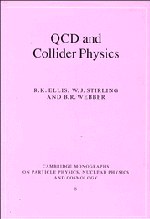Book contents
- Frontmatter
- Contents
- Preface
- 1 Fundamentals of QCD
- 2 Asymptotic freedom and confinement
- 3 QCD in electron-positron annihilation
- 4 Deep inelastic scattering
- 5 Parton branching and jet simulation
- 6 Jet properties beyond fixed order
- 7 Hadroproduction of jets and photons
- 8 Electroweak interactions
- 9 The production of vector bosons
- 10 Heavy quarks
- 11 Higgs bosons at high-energy colliders
- 12 Measurements of the strong coupling constant
- Index
6 - Jet properties beyond fixed order
Published online by Cambridge University Press: 05 May 2010
- Frontmatter
- Contents
- Preface
- 1 Fundamentals of QCD
- 2 Asymptotic freedom and confinement
- 3 QCD in electron-positron annihilation
- 4 Deep inelastic scattering
- 5 Parton branching and jet simulation
- 6 Jet properties beyond fixed order
- 7 Hadroproduction of jets and photons
- 8 Electroweak interactions
- 9 The production of vector bosons
- 10 Heavy quarks
- 11 Higgs bosons at high-energy colliders
- 12 Measurements of the strong coupling constant
- Index
Summary
We illustrated in Chapter 3 the use of perturbation theory to calculate ‘infra-red safe’ quantities such as the e+e− total cross section and thrust distribution. There are in addition predictions that can be made concerning some quantities that are ‘infra-red sensitive’, i.e. that have infra-red and collinear singularities in perturbation theory. Such quantities can still be handled provided the singularities can be collected into an overall factor which describes the sensitivity of the quantity to long-distance physics. The divergence of this factor corresponds to the fact that longdistance phenomena are not reliably predicted by perturbation theory. For example, quarks and gluons are free to propagate over macroscopic distances in perturbation theory, whereas in reality they are confined inside hadrons. Therefore the divergent factor should be replaced by a finite factor determined experimentally by measurements at a relatively short distance scale. Once this is done, perturbation theory can be used to predict the scale dependence of the quantity.
The best known example of a perturbative prediction of a factorizable infra-red-sensitive quantity is the phenomenon of scaling violation, discussed in Chapter 4. There we studied the parton distributions inside a hadron, probed by deep inelastic lepton scattering. Here we consider the related phenomenon for the fragmentation of a jet, produced for example in e+e− annihilation, into hadrons of a given type h.
Jet fragmentation
We start by defining fragmentation functions, which are dimensionless functions that describe single particle distributions in the final state.
- Type
- Chapter
- Information
- QCD and Collider Physics , pp. 193 - 236Publisher: Cambridge University PressPrint publication year: 1996



